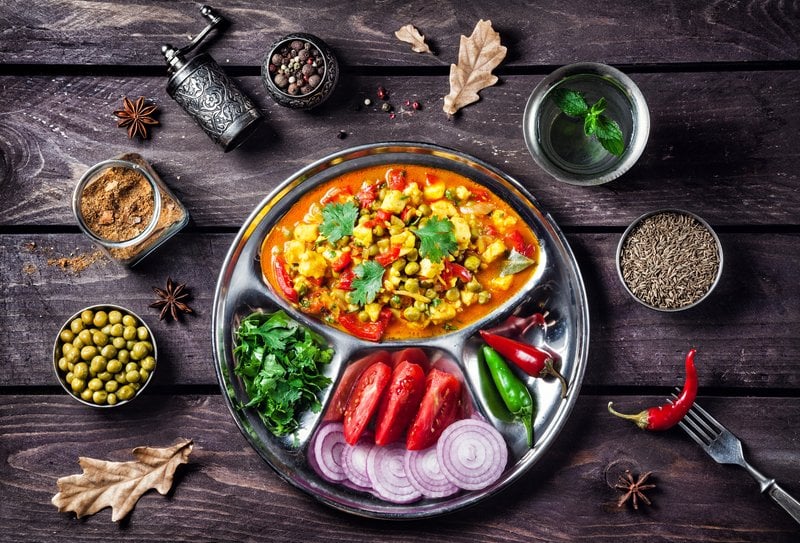Ayurvedic Diet: See the Benefits, Downsides & How It Works

The focus of many, though certainly not all, diets is on weight loss. The Ayurvedic Diet, instead, focuses on boosting health, promoting vitality, increasing energy, preventing (or managing) disease states, and maintaining overall wellness by dictating when, what, and how to eat. 1
A famous Ayurvedic proverb provides great insight into the diet and what it’s all about: “When diet is wrong, medicine is of no use. When diet is correct, medicine is of no need.”
Like any quality diet, the Ayurvedic Diet promotes eating mostly whole, minimally processed foods. It also encourages mindful eating rituals. Unlike modern “fad” diets, however, the Ayurvedic Diet has a long, long history of use—around 5,000 to 6,000 years—as part of the Hindu system of medicine, which comes from the Vedic text. 2,3
In today’s article about the Ayurvedic Diet, we go over the following:
- What is Ayurveda?
- What is Your Dosha?
- How to Follow the Ayurvedic Diet
- Vata Dosha Guidelines
- Pitta Dosha Guidelines
- Kapha Dosha Guidelines
- Ayurvedic Lifestyle
- Benefits and Downsides of Ayurvedic Diet
What is Ayurveda?
Ayurveda (pronounced ai-yr-vei-duh) originated in India to promote wellness and prevent health problems. The word itself is a combination of two Sanskrit words that mean life science (or knowledge), or “the science of life.” The goal of the practice is to create a strong, healthy body, and it combines lifestyle practices—like mindfulness and quality sleep—with a healthy diet and exercise. 4
To follow this type of diet, you’ll need to incorporate personalized practices, which will vary depending on your “dosha.” Dosha can be thought of as your prominent energy or constitutional type, or even more simply, as your body type. There are three primary doshas that are developed from the five elements: earth (Prithvi), air (Vayu), fire (Teja), water (Jala), and space (Aakash). 3
What is Your Dosha?
To discover your dosha, read the descriptions below to see which one seems to fit your personal attributes best:
- Vata (air and space) is a cold, dry dosha that’s expressive, intense, creative, anxious, active, quick thinking, always moving and changing with rapid speech. However, vatas typically aren’t planners and can experience irregular digestion, constipation, and bloating. And when out of balance, they can experience fatigue or anxiety. Physically, vatas have smaller frames and eyes with prominent bones and wavy, thick hair.
- Pitta (water and fire) is a hot, intense dosha that’s driven, intelligent, sharp, and aggressive. Pittas tend to provide impactful ideas and solutions but can sometimes come across as short tempered. Physically, pittas have a moderate frame and may have moles and freckles as well as silky, soft hair. They also tend to enjoy a good metabolism, digestion, and appetite. When out of balance, they tend to suffer from indigestion, heart disease, or high blood pressure.
- Kapha (earth and water) is a heavier, slower, soft dosha that tends to be naturally loving, loyal, grounded, calm, strong, mellow or lethargic, and heavier with slow, melodic speech and almost fluid movements and smooth, radiant skin. They also tend to have a larger frame with well-developed muscles but a slower metabolism. When out of balance, they can easily gain weight or suffer from breathing issues, depression, and diabetes.
We all have aspects of the three doshas and are composed of our unique combination of energies based on our physical, mental, and emotional attributes. Yet, Ayurveda says that we all have a dominant dosha that remains consistent from birth through life with a fluctuating balance of the other doshas, and it’s best to eat to support inner balance and harmony between the body and the mind.
The most accurate, smartest way to discover your dosha is by visiting an Ayurvedic practitioner, who can then recommend the right combination of foods and herbs to help you find balance for your dosha and assist with any health concerns. If you don’t have access to an Ayurvedic doctor, there are online Ayurvedic assessment questionnaires to help you figure out a more well-defined plan. (They can be subjective and aren’t, however, always as accurate as a personal assessment.)
Following the Ayurvedic Diet
According to Ayurvedic practitioners, when the doshas are balanced, we’re healthy mentally and physically. If they become unbalanced or stressed, however, health issues can arise and often become evident as skin problems, digestive complications, difficulty sleeping, irritability, anxiety, and other negative emotions.
To follow the Ayurvedic Diet, you will choose your strongest dosha to determine how you eat to nourish your body and balance your energies. A complete list foods to avoid and to favor is available from Ayurveda.com, but here’s a quick sample for each dosha:
Diet Guidelines for Vata Dosha
Foods to Favor for Vata Dosha:
- Most Sweet Fruits: Apricots, Berries, Cherries, Grapes, and Strawberries
- Cooked Vegetables: Asparagus, Green Beans, Sweet Potatoes, Peas, Cooked Spinach
- Grains: Cooked Oats, Rice, Quinoa, Sprouted Wheat, Seitan
- Legumes: Red Lentils, Mung Dal, Urad Dal
- Dairy: Most Dairy is Good for Vata Dosha
- Animal Foods: Beef, Buffalo, Chicken, Salmon, Shrimp, Tuna
- Miscellaneous: Black Pepper, Chutney, Ketchup, Lemo, Lime
Foods to Avoid for Vata Dosha:
- Most Dried Fruits: Cranberries, Pears, Pomegranates, Raisins, Prunes
- Frozen, Raw or Dried Vegetables: Broccoli, Brussel Sprouts, Olives, Onions, Kale, Tomatoes
- Grains: Barley, Bread with Yeast, Crackers, Couscous, Granola, Rye
- Legumes: Black Beans, Black-Eyed Peas, Chick Peas, Pinto Beans, Soy Powder
- Dairy: Powdered Milks and Yogurt
- Animal Foods: Lamb, Pork, Rabbit, Turkey
- Miscellaneous: Chocolate, Horseradish

Lifestyle Keys to Vata Dosha:
Lifestyle is also important. Suggestions to stay in balance for a vata dosha include:
- Maintaining a routine
- Exercising gently
- Finding time to rest and restore in a calm, safe, and comforting environment
- Enjoying regular massages
- Avoiding cold, windy conditions and dry climates
- Minimizing travel and movement and avoiding loud, noisy environments
- Getting enough sleep
- Staying warm
Diet Guidelines for Pitta Dosha
Foods to Favor for Pitta Dosha:
- Most Sweet Fruits: Apricots, Berries, Cherries, Grapes, and Strawberries
- Sweet and Bitter Vegetables: Asparagus, Broccoli, Carrots, Leafy Greens, Mushrooms, Olives, Onions
- Grains: Bread, Oats and Rice
- Legumes: Black Beans, Kidney Beans, Chickpeas, Lima Beans and Tofu
- Dairy: Unsalted Butter, Soft Cheese, Ice Cream
- Animal Foods: Buffalo, White Meat Chicken, White Meat Turkey, Freshwater Fish
- Miscellaneous: Black Pepper, Almonds, Sesame Seeds, Avocado
Foods to Avoid for Pitta Dosha:
- Most Sour Fruits: Sour Cherries, Apples, Rhubarb, Lemons
- Most Pungent Vegetables: Garlic, Mustard Greens, Spinach, Tomatoes, Hot Peppers
- Grains: Amaranth, Barley, Couscous, Brown Rice
- Legumes: Miso, Soy Sauce, Tur Dal, Urad Dal
- Dairy: Salted Butter, Hard Cheeses, Sour Cream
- Animal Foods: Beef, Dark Meat Chicken, Egg Yolks, Salmon, Sardines, Dark Meat Turkey
- Miscellaneous: Chili Pepper, Chocolate, Mayonnaise, Pickles

Lifestyle Keys to Pitta Dosha:
Lifestyle is also important. Suggestions to stay in balance for a pitta dosha include:
- Getting lots of fresh air and exercise when it’s cooler
- Staying cool physically as well as mentally and striving for moderation
- Avoiding excessive heat, steam, and humidity
- Consuming plenty of fluids
- Learning to be patient and considerate with others
- Finding quiet and contemplative activities to enjoy
- Avoiding conflict
Diet Guidelines for Kapha Dosha
Foods to Favor for Kapha Dosha:
- Most Astringent Fruits: Apples, Apricots, Cherries, Prunes, Raisins
- Most Pungent and Bitter Vegetables: Asparagus, Beets, Broccoli, Cauliflower, Kale
- Grains: Amaranth, Barley, Couscous, Polenta, Wild and Basmati Rice
- Legumes: Black Beans, Chick Peas, Lima Beans, Peas, Pinto Beans
- Dairy: Buttermilk, Cottage Cheese, Goat’s Cheese
- Animal Foods: White Meat Chicken, Eggs, Freshwater Fish, Shrimp
- Miscellaneous: Black Pepper, Horseradish, Flax Seed Oil, Ghee
Foods to Avoid for Kapha Dosha:
- Most Sweet and Sour Fruit: Avocado, Bananas, Oranges, Watermelon
- Most Sweet and Juicy Vegetables: Cucumbers, Olives, Sweet Potatoes, Tomatoes
- Grains: Leavened Bread, Cooked Oats, Pancakes, Brown and White Rice
- Legumes: Kidney Beans, Soy Products, Miso
- Dairy: Butter, Cheese and Ice Cream
- Animal Foods: Beef, Buffalo, Pork, Salmon
- Miscellaneous: Chocolate, Salt, Lime, Mayonnaise, Vinegar

Lifestyle Keys to Kapha Dosha:
Again, lifestyle is also important. Suggestions to stay in balance for a kapha dosha include:
- Awakening early (even before dawn) and avoiding sleep during the day
- Ensuring you enjoy plenty of exercise daily
- Finding activities to stimulate the mind and body and boost metabolic rate
- Encouraging excitement, challenge, and variety
- Finding ways to break away from old ways of thinking and behaving or falling into a rut
- Keeping warm and dry
Lifestyle Recommendations for All Dosha Types
In addition to eating specific foods and adhering to specific lifestyle recommendations, there are several other Ayurvedic practices to follow for all of the doshas:
- Include a small amount of all six tastes (or rasas—i.e., sweet, salty, sour, bitter, pungent, and astringent) with each meal.
- Start each meal with a sweet taste (e.g., fruit)
- Then eat a salty food (e.g., seafood) with a sour food (e.g., citrus fruit)
- Finally, end the meal with foods that are pungent (e.g., peppers and onions), astringent (e.g., tea), and bitter (e.g., leafy green vegetables)
By eating the six tastes, you’re likely to get a wide variety of healthy nutrients. The amount of each taste, however, will depend on your specific dosha. It’s important to note that even if a food isn’t recommended for your dosha, there are no off-limit, or “bad,” foods. As you follow the diet, you’re encouraged to tune into your body and how it reacts to the foods you eat, personalizing the diet to what makes you feel best.
- Choose foods that positively influence your digestion, as gut health is vital to the Ayurvedic Diet.
- Eat slowly and mindfully without distractions, such as TV, music, emailing, reading, or even talking with others to fully focus on your meal and savor the flavors. You also want to eat quickly enough to ensure your food doesn’t get cold. Start by pausing before each meal to deeply notice the smell and colors of your meal before eating. Then try taking one meal a day in complete silence to deeply connect with the food—including the colors, flavors, and awareness of how the food came to you to provide energy through the growth cycle with sun, soil, and earth.
- Honor your hunger signals to eat until you reach fullness but avoid overeating. If hunger is measured 0 to 10, eat when you hit a 2 and stop when you hit 7, so you’re neither overly hungry nor overly full.
- Wait at least three hours between meals so each meal can be fully digested before eating again. But avoid getting overly hungry by not waiting more than six hours. (In other words, avoid snacking, which can lead to incomplete digestion, which, according to Ayurvedic principles, can result in increased toxins.)
- The main meals are breakfast and lunch. Start with a more modest breakfast and enjoy a larger, more satisfying lunch and a lighter dinner, if you’re hungry in the evening.
- Promote prana energy by eating only whole, fresh foods and ensuring you get plenty of sunshine, water, and earth energies. Support local agriculture and farmers markets to find fresh foods that provide abundant life force (aka prana) and sustain the earth.
- Avoid consuming ice-cold foods and drinks to support your inner fire, or agni, which provides energy and digestive power. People with vata and kapha doshas, in particular, should try to consume more warm foods and teas. People with a pitta dosha can consume cool, though not frozen, foods and drinks to keep digestion running well.
- Prepare for sleep by having your last meal at least three hours before bedtime. Again, have a light dinner, so the body can focus on repairing, healing, and restoring as you sleep.
- Enjoy herbal teas liberally between meals to please the palate and restore health and vitality. With meals, however, consume no more than a half cup of beverages, including water or tea.
- Vata doshas drink spicy cinnamon, ginger, and clove teas to support grounding or calmness.
- Pittas drink cooling herbs like peppermint, coriander, or rose.
- Kaphas drink licorice, black pepper, or cardamom teas to increase energy and optimism and support digestion.
- Exercise, sleep, meditation, and breath are also powerful pillars of health for a well-balanced energy for any dosha. And a spiritual relationship with food is also encouraged.
Benefits and Downsides of Following the Ayurvedic Diet
Because the focus of the Ayurvedic Diet is on whole, unprocessed foods along with slow and mindful eating, it can help some people drop unwanted pounds. On the other hand, the diet can be very restrictive, and it can be challenging to find out your dosha; or, you may find that you are a mix of doshas, leading to conflicting recommendations. Plus, discovering your dosha is the result of subjective questioning, so it may not be completely accurate.
What’s more, there are complicated rules to follow, which can make sticking to the diet difficult over the long term. Many people have found it challenging to stick to the program as the food choices are limited and may not be all that appealing. Others find the diet confusing as the foods you eat change by season. And it can be difficult for a family to prepare meals for multiple different doshas.
A potential benefit, as well as drawback, of the diet is that it doesn’t provide specific calorie, macronutrient, or food group recommendations. Rather, it depends on following your body’s own hunger and satiation cues as well as how you feel to guide the diet. In fact, practitioners warn against making the Ayurvedic Diet a “diet” that limits and restricts eating.
There are also a lot of claims regarding the health benefits of the Ayurvedic Diet, yet many of these tend to be observational but not backed by scientific research. New studies are, however emerging, suggesting, for example, that:
- Ayurvedic may help people adhere to new, healthier behaviors. 5
- It promotes mindfulness, which may reduce bodyweight and binge eating as well as decrease stress and depression. 6 Mindfulness has also been shown to help promote self-control and a healthier relationship with food. 7
- It may provide psychosocial health benefits. 8
- It may help support improved outcomes with certain respiratory, musculoskeletal, and circulatory illnesses. 9
- It may support weight management. 10, 11
Some Ayurvedic practitioners recommend a more relaxed or flexible dieting approach. Rather than focusing on dosha-specific foods, for example, they may recommend a more intuitive eating and exercise practice and finding foods that make you feel good, aid in digestion, and support your energy levels. The focus, therefore, is less on weight-loss dogma and restrictive rules, and rather, more on overall wellness, choosing nutritious whole foods, and managing portions.
No matter how closely you follow the Ayurvedic Diet, however, an important component is developing a spiritual relationship with your food. The next most important aspect is ensuring the gut is healthy. If your digestion is good, then everything else will be fine. The goal is to create harmony between yourself, nature, and the foods you enjoy. Ayurvedic living is not just science but the art of living in balance and harmony.








